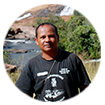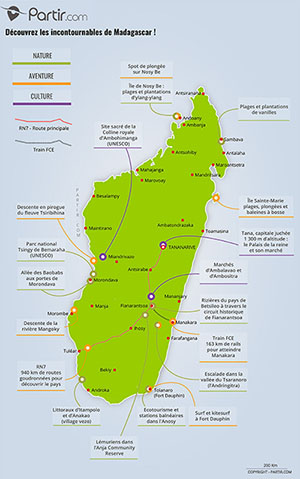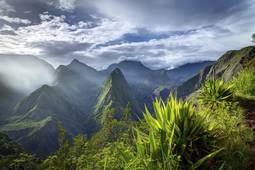Plan an amazing trip to Madagascar
Do you want to take off to a sunny and fascinating place? Madagascar is a destination which will delight you with its white sand beaches, luxuriant vegetation, rice fields and baobabs. Separated from Africa by the Mozambique Channel, the island of Madagascar is a fascinating blend of the Asian and the African. On your trip to Madagascar you will discover landscapes which will surprise and captivate you at every step. The north and its small islands are a particularly exotic tropical paradise. To the west, reminding us of nearby Africa, the savannah is dotted with the shadows of baobab trees and crossed by many rivers. To the east, beautiful beaches and turquoise lagoons set among the luxurious vegetation await the visitor. The tropic of Capricorn crosses the south of the country where the suns reigns supreme all year. The ancient palaces in the central country are fascinating, as is the surprising terrain which has been marked by erosion. Visiting Madagascar is to find yourself on an exotic adventure. Discover its culture and the main places of interest.

Andry's tips, local guide
Best time to go to Madagascar
Before planning your holidays, you need to decide when is the best time to visit Madagascar. Madagascar has a tropical climate: the winter is as cold and dry as the summer is hot and humid. Madagascar has a rainy season from November to April. If you are planning a trip to Madagascar, it's best to avoid the rainy season due to the frequent cyclones.
My favourite months are April for sightseeing and discovery. The countryside after the rain season is magnificent. And August for the coastal trails.
The best time to visit Madagascar is therefore the dry season from April to September. However, although the weather is pleasant (21ºC - 26ºC) the temperature rapidly drops in the mountains. Bring warm clothing if you want to visit the highlands.
Andry answers your most frequently asked questions
It is not advisable to drink the tap water. Only drink bottled water. Avoid eating raw fruit and vegetables which have not been washed and peeled. To be sure, peel fruit and veg yourself and remember to wash your hands before preparing and eating food. If you cut yourself, wash the wound immediately. It may take longer to heal in Madagascar's hot and humid climate.
The majority of tourist destinations are safe. When you are walking around, follow a few simple rules to blend in with the crowd. Dress simply without obvious signs of wealth. Don't display valuables (cameras or mobile phones, for example). Don't keep all your money in one bag, and distribute the rest among several pockets. Beaches close to hotels are monitored by caretakers.
Madagascan cuisine is not very varied, but it is flavoursome and fragrant. Rice is the staple food for most of the population. It often accompanies meat and vegetable dishes. Among traditional Madagascan dishes are "Romazava," a stew of zebu meat, tomatoes and vegetables and "henakisoa sy ravitoto," pork served with mashed cassava leaves. As for desserts, Madagascans generally eat fruit, but there are a few local specialities such as "koba," a kind of rice flour cake with crushed peanuts and bananas, cooked in banana leaves. There are also the island's typical "menakely" - banana doughnuts. To drink, there is ranonapango, the favourite drink of Madagascar. The drink is made from the burnt rice stuck at the bottom of the pan. It is often served, hot or cold, at Madagascan meals.
You want to visit Madagascar for a two week stay, and you want to know what to do? For two weeks, it's best to focus on one geographic zone: the south or the east. For a trip through the south, Tanà, Antsirabe, Ambositra, Ranomafana-Manakara (Pangalane Canal), Ambalavao, Andringitra, Isalo and Mangily are the key stops. For the east, stop in Tanà, Andasibe (Pangalanes Canal), Tamatave, Foulpointe and Mahambo, and why not finish your stay on the idyllic island of Saite-Marie?
Take our word for it, if you're not experienced, driving here is difficult. To get around, I recommend flying or hiring a car and driver or even taking a bush taxi.
The internet is available everywhere. GPS is rare.
There are four tours which allow you to observe lemurs:
Andasibe National Park is unmissable if you want to see Indri-indri, the largest lemurs in Madagascar. Or you can see different species of lemur in the private Vakona Park where you can feed and stroke them too. Vakona Park is managed by the villagers themselves.
In the south, there are several parks where you can see lemurs: Ranomafana, the private Anja Park in Ambalavao, Camp Catta in Andringitra and Isalo National Park.
In the north, head for Ankarana and the Amber Mountain National Parks to see lemurs.
In the west, you can only see the adorable critters in Morondava National Park.
West Madagascar lends itself to admiring baobabs: Morondova and Majunga will bowl you over. To the south, Mangily is the choice destination.
Crafts in Madagascar are very diverse. Crafts are an important part of the island's economy, and the majority of products are destined for export. In the centre of the island, embroidery is a skill handed down from mother to daughter. Embroidered cloth from table cloths to dresses are very popular with tourists. Wild and natural silks make their way into bags and shoes as well as "lamba," the scarves Madagascan women drape themselves in for traditional ceremonies. Madagascan artisans also enjoy working with wood. In Zafimaniry art, precious woods is sculpted to make furniture and decorative objects. Zebu horn is turned to make jewellery and kitchen utensils. Tin smithing is another local skill and Madagascan artisans transform beer and food cans into cars, motorbikes and other playful miniature objects.
- Transport is a weak point in Madagascar. In some regions, the state of the roads resembles a warzone.
- The sensitive climate of security.
Madagascar is spoilt for nature. Its flora and fauna are as varied as they are unusual as the majority of species are endemic to the island. Hospitality is not an empty word in Madagascar where foreigners are welcomed warmly.

























